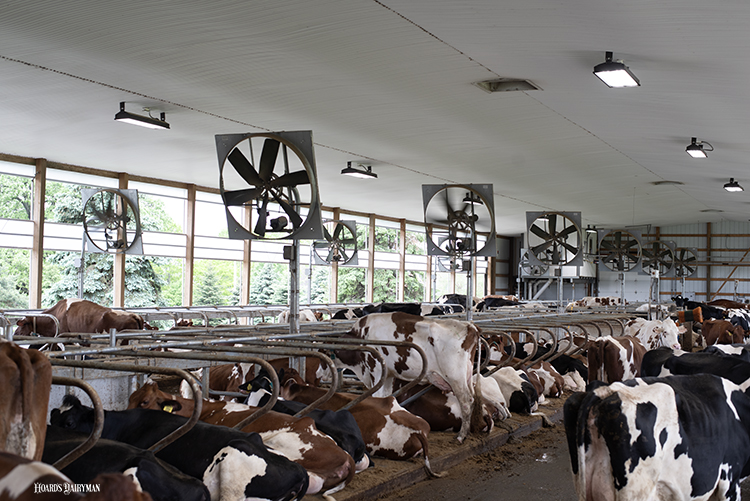
The calendar says it is officially summer, and temperatures in many parts of the country are heating up. On a recent University of Minnesota “Moos Room” podcast, a listener asked about the ideal temperature inside a barn housing dairy cattle.
Joe Armstrong, D.V.M., a University of Minnesota extension educator, noted that the ideal temperature depends on the type of barn, time of year, and the age of the cattle being housed. He focused much of his discussion on facilities that were mechanically ventilated.
Armstrong pointed out that cows can be heat stressed when the temperature-humidity index (THI) rises above 68. With 75% humidity, a barn needs to be kept under 70°F to stay below that THI threshold.
He acknowledged that some days, it is unavoidable that cows experience some level of heat stress. He also noted that like people, each cow is different and can becomes heat stressed at a different temperature.
Armstrong said that the presence of heat stress can be monitored by tracking respiratory rates. He recommended calculating respiratory rates for a group of 10 cows at certain times of the day to get a good snapshot of that is happening in the barn. In general, cows are under heat stress when their respiratory rate rises above 60 breaths per minute. If a farm is interested in investing in technology, there are also sensors available that can be placed in cows to track body temperature and monitor for heat stress.
To cool a barn, Armstrong said the first step is to tackle the ventilation. “Take care of the ventilation parameters, and then see what else you have to do,” he shared. In summer, dairy barns need a minimum of 60 air exchanges per hour, he said. That means all the air in the barn must leave and be replaced by fresh air at least once every minute. “That is the first step in controlling humidity and keeping cows cool,” Armstrong reiterated. If that’s not enough, then other measures, such as mixing fans or soakers, may need to be added.
For winter, ventilation is still the focus, but the recommendation is at least four air exchanges per hour. Armstrong advised keeping the barn as well ventilated as possible without freezing waterers, creating icy floors, or making working conditions too uncomfortable for caretakers.
Winter ventilation can be particularly difficult with calves as they are more susceptible to the cold than are adult cattle. Armstrong said a lot of it comes back to how those calves are fed. Preweaned calves on a higher plane of nutrition, being fed greater amounts of high-quality milk or milk replacer, are able to handle colder temperatures better than calves receiving fewer nutrients.
Armstrong also noted that for barns housing both youngstock and adult cattle, it is important that air travels from the younger animals to the older animals rather than the other way around. Even though this presents some challenges in the winter when cold air is being pulled over the calves before it has a chance to warm up, for biosecurity reasons, it is best for calves to receive the freshest air that has not flowed through adult cattle first.








